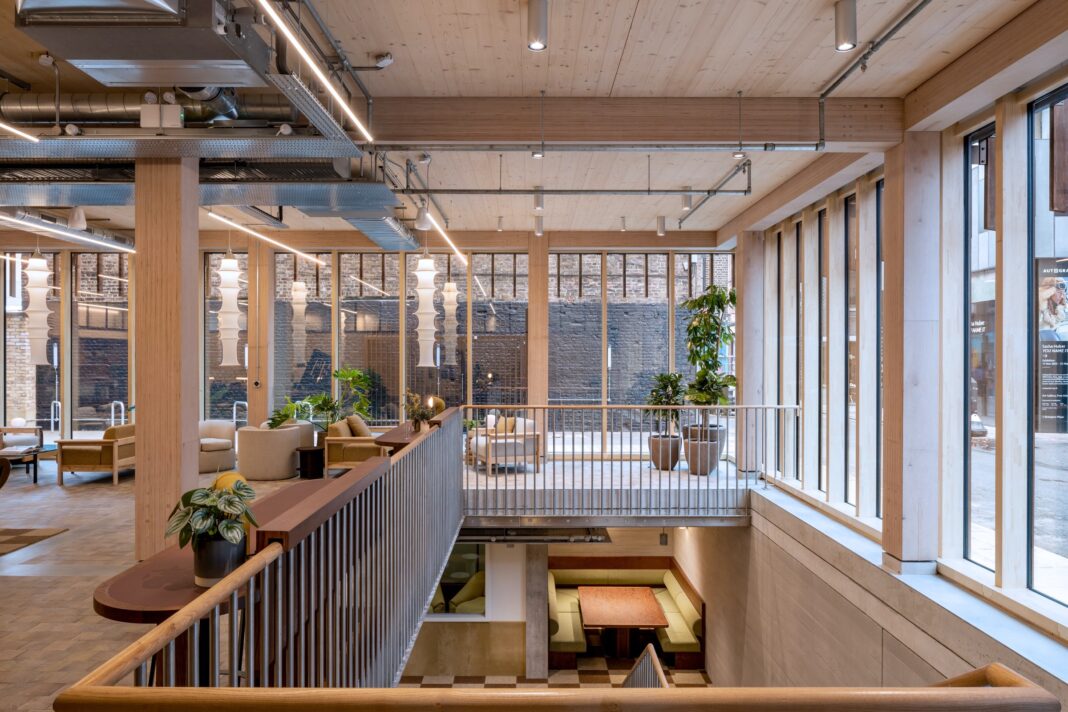Architect Andrew Waugh, a strong proponent of timber construction, believes that architects need to break away from the concrete mindset and develop a unique approach to mass timber design.
In an interview for Dezeen’s Timber Revolution – the latest in the series, Waugh emphasized the importance of considering how timber buildings will stand and how individual components will hold them together, rather than focusing solely on height and form. He argues that the success of timber should be framed within its own narrative, rather than being compared to concrete.
Pioneering Projects and a Timber-Focused Approach
Waugh Thistleton Architects, founded by Waugh, has been at the forefront of developing cross-laminated timber (CLT) structures for over 15 years. In the past has been a strong proponent of CLT being used to solve global housing affordability.

The firm has worked on innovative projects such as Murray Grove, Dalston Works – the world’s largest timber building at time of construction, and the Black & White Building for The Office Group.

These projects showcase the potential of mass timber in residential and commercial applications, with each building designed using a component-based approach and consulting engineers from the early stages of the design process. Currently, the practice focuses almost exclusively on wood-based projects, showcasing a commitment to sustainable architecture.
Rethinking Measures of Success
Waugh argues that architects should consider alternative measures of success when designing timber buildings. Traditional benchmarks, such as building height, might not fully capture the potential of timber as a construction material. Instead, he suggests focusing on material efficiency, wellbeing impact, or even the Scandinavian concept of “hygge” (cosiness). Waugh is critical of the trend for timber high-rises, questioning whether they make the best use of the material and suggesting that architects should concentrate on the unique qualities of wood instead.

The Expanding Mass Timber Market
Although there are only 70 CLT manufacturers worldwide at present, Waugh expects this number to increase as the mass timber market continues to grow.
Closer to home, CLT is surging in Australia and New Zealand with Xlam, NeXTimber by Timberlink and Cusp adding to more than 20 importers who have serviced the market in recent years.
Waugh believes that timber yield could be significantly increased with better forest management and a reduced reliance on burning wood as an energy source. Waugh added:
“We need to plant more trees and get better at using them, by burning less and being more efficient.” He said, “But it’s not like we’re going to run out of trees anytime soon.”

Waugh also pointed out that just a decade ago, there were only a handful of CLT manufacturers, indicating that the industry is evolving and expanding rapidly.
Overcoming Technical Challenges
Waugh acknowledges that mass-timber construction comes with its own set of technical challenges, such as waterproofing, but remains confident that these issues will be resolved as knowledge and experience with mass-timber buildings grow.
He envisions a timber revolution driven by investment funds demanding low-carbon buildings, rather than solely relying on legislation. Waugh states:
“If you had asked me 10 years ago, I would have said that legislation would drive greener buildings. “Instead, it’s money that is driving change. Investment funds are demanding low-carbon buildings, because they don’t want to be owning big concrete and steel buildings in 10, 20 or 50 years time.”
Andrew Waugh, Waugh Thistleton Architects
‘Green finance’ is a major driver of the shift to mass timber, last year the Australian Clean Energy Finance Corporation (CEFC) introduced a new ‘Timber Building Program’ encouraging the building and construction industry to invest in sustainable, low-carbon timber projects.
Waugh compares the current learning curve with timber to the challenges faced with concrete when it was first introduced, indicating that these hurdles can be overcome with time and research.
Embracing a Paradigm Shift in Architecture
Waugh warns that the current interest in timber construction should not be treated as a passing trend but as a complete shift in architectural values. He emphasizes the importance of architects recognizing timber as a fundamental material that can transform the way buildings are designed and constructed, ultimately leading to a more sustainable future. Waugh stresses that this is not just a matter of adding timber to an architect’s palette of materials, but rather a fundamental change in the way we think about the values and goals of architecture as a whole.

Andrew Waugh’s insights into the timber revolution highlight the need for architects to embrace a new mindset and approach to mass timber design. By rethinking measures of success and overcoming technical challenges, the architecture industry can help pave the way for a more sustainable future through timber construction.
- With extracts from Dezeen Magazine.







